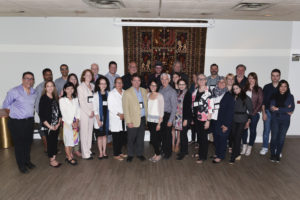Home » Posts tagged 'Teaching'
Tag Archives: Teaching
Finding the Connection

Colleges and universities in the U.S. and Canada are increasingly becoming ethnoculturally and linguistically diverse which is partially due to increasing enrolment of international students. Currently, 1.4 million international students choose to study at Canadian and U.S. post-secondary educational institutions, which increased by 7.1 percent between 2015 and 2016 (Canadian Bureau of International Education, 2016; Institute of International Education, 2016).
Currently, campus internationalization initiatives focus primarily on external areas including education abroad and student exchange, recruiting international students, and institutional partnerships. However, this is expected to change as more institutions are developing academic-related internationalization initiatives (e.g., international or global student learning outcomes, related general education requirements, foreign language requirements). A growing number of institutions are increasing faculty engagement in internationalization efforts. To do this, faculty will need to critically examine their role in campus internationalization and implement teaching strategies that address international student success factors.
In a recent study, we explored the promising teaching practices for teaching linguistically and culturally-diverse international students by identifying the teaching practices that have high levels of international student satisfaction and student perceptions of learning. This study is based on the belief that the most effective teaching practices are where promising teaching practices, student satisfaction, and student perceptions of learning meet.
We found that the promising teaching practices identified as having high levels of student satisfaction also have medium/high student perception levels of learning. We also found a positive correlation between student satisfaction and student perceptions of learning for each of the promising teaching practices. In particular, fourteen correlations were reported at the .700 level or higher, suggesting a strong positive correlation, including assessing needs, assignments, clarifying expectations, class preparation, culturally-responsive teaching, feedback, and language proficiency. Our hope is that faculty who engage in these teaching practices will become more engaged in campus internationalization and improve international student success on their campuses.
We are currently engaged in a student-informed research project that will see us compare international student satisfaction for STEM (Science, Technology, Engineering, and Mathematics) and non-STEM international students to learn more about why STEM and non-STEM students have different views on the effectiveness of the promising teaching practices.
For more information and to follow our project, here is the link to our research web page.
Yours internationally,
Clayton Smith
References
Canadian Bureau of International Education (2016). A world of learning: Canada’s performance and potential in International education. Ottawa: CBIE.
Institute of International Education (2016). Open doors 2016. New York, NY: IIE.
Taking the Plunge

After more than 30 years engaged in higher education administration in the U.S. and Canada, I took the plunge and returned to my teaching roots. And what an adventure it has been!
I took nearly everything that our Centre for Teaching and Learning offered as a way of rebooting and modernizing my approach to teaching. This took me through the Certificate in University Teaching, Blackboard Boot Camp, the Teaching Dossier Academy, and lots more. I learned about SoTL and scholarly teaching. It resulted in me adopting “teaching for learning” as my teaching style, which, of course, was a perfect match to my dean of students’ experiences putting students first in all we do.
More recently, I have explored the open practice world with the help of our Office of Open Learning. It has left me inspired to move away from traditional pedagogies and adopt a more open path to teaching and learning. This led me to explore educational technologies, curation, collaboration, experimentation, and scholarship related to open practice. I am even currently considering the development of an Open Educational Resource for one of my courses and have now created an ePortfolio!
The combination of “teaching for learning” and entering the open learning world has led me to want to learn more about how we as educators, teachers, researchers, and supporters of student learning can more fully centre our work on enhancing student learning.
Where this adventure will lead me, I do not know. What I hope is that it will make me a better teacher, facilitator, mentor, and coach for my students.
I cannot wait to experience what is next on my journey.
From time to time, I will write in this blog about my experiences. Maybe you will tune in and reflect with me about how you incorporate “teaching for learning” and open learning pedagogies in your teaching.
Join me!
Clayton Smith
Recent Comments